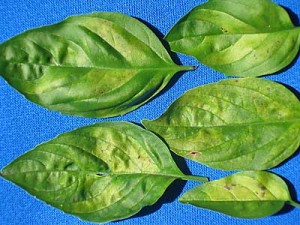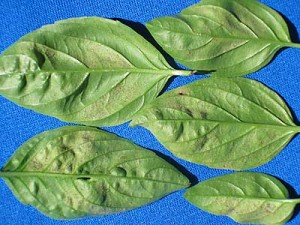Planning on pesto? Basil downy mildew can leave you with a pot of pasta and no sauce.
Basil downy mildew is a disease that can survive on the seed and infect the plant as soon as it germinates. It can also travel by airborne spores and infect plants that started out clean. It only affects basil – but that isn’t good news when you’re hungry for fresh basil on your mozzarella.
What can you do to prevent the disease? Start with a variety that is resistant –red leafed, Thai, lemon, lime and spice types are less likely to get sick than the common sweet basil varieties. Space your plants far enough apart to get good air flow between them and some sun reaching all the leaves. Basil downy mildew is a water mold so it likes high humidity and tight plants make for damp conditions. And water from below – drip irrigation if you have it – to keep the leaves dry.
If the basil is already looking lush, scout your plants. Look for yellowish areas on the upper surface of the leaves. When you turn the leaves over, you will see gray speckles and fuzzy growth – that’s the disease producing more spores to send out on the next air current. Sometimes the yellowish areas on the leaves will turn brown and die. If only a few plants are affected, remove them as soon as possible – bagging the sick plants to avoid spreading spores to the healthy ones.


One positive note? Just like late blight in tomatoes, basil downy mildew does not survive in the soil so you can start clean again next year.
Want more information? See Meg McGrath’s article on basil downy mildew, Expect and Prepare For Downy Mildew in Basil.